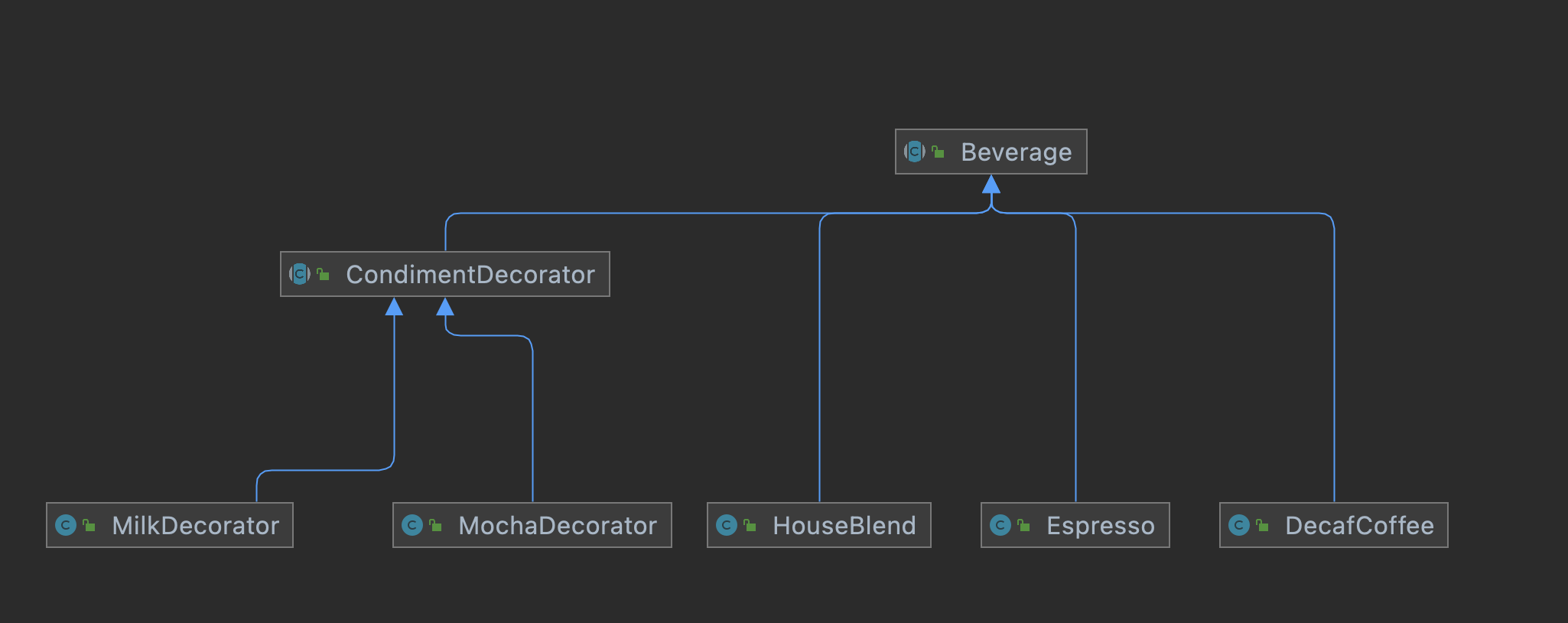装饰者模式
1. 装饰者模式Overview
- Attach additional responsibilities to an object dynamically. Decorator provides a flexible alternative to subclassing for extending functionality.
- inheriting behavior at runtime through composition and delegation
- open for extension but close for modification
- decorator has the same super type as the objects they decorate
- we could use one or more decorators to wrap an object
- the decorator adds its own behavior before and/or after delegating to the object it decorates to do the rest of the job
2. 使用场景
- when we want to give some other responsibility at run time
- kind of like continue to wrap the intrinsic object with some new responsibility, still an is-a relationship
3. 使用目的
- Extends the class at run time instead of compile time
- To give objects some new responsibilities without making any code changes to the underlying classes
- pitfall
- sometimes it could lead to a lot of new classes
4. 具体实现
One highlight
the condimentDecorator is a beverage, and also need to has a beverage
we are using inheritance to achieve the type matching, but we aren’t using inheritance to get behavior

4.1 接口和数据对象定义
public abstract class Beverage {
String description = "Unknown Beverage";
public abstract double cost();
public String getDescription() {
return description;
}
}
public abstract class CondimentDecorator extends Beverage{
Beverage beverage;
public abstract String getDescription();
}4.2 具体实现类的定义
public class DecafCoffee extends Beverage {
@Override
public double cost() {
return 2.5f;
}
String description() {
return "Decat coffee";
}
}
public class Espresso extends Beverage{
public Espresso() {
description = "Espresso";
}
@Override
public double cost() {
return 4;
}
}
public class HouseBlend extends Beverage{
public HouseBlend() {
description = "House Blend Coffee";
}
@Override
public double cost() {
return 0.99;
}
}
public class MilkDecorator extends CondimentDecorator{
public MilkDecorator(Beverage beverage) {
this.beverage = beverage;
}
@Override
public double cost() {
return beverage.cost() + 0.8;
}
@Override
public String getDescription() {
return beverage.getDescription() + "with milk";
}
}
public class MochaDecorator extends CondimentDecorator{
public MochaDecorator(Beverage beverage) {
this.beverage = beverage;
}
@Override
public double cost() {
return beverage.cost() + 0.5;
}
@Override
public String getDescription() {
return beverage.getDescription() + "with Mocha";
}
}4.3 测试
@GetMapping("/decorator")
public String decorator() {
Beverage decafCoffee = new DecafCoffee();
log.info("before decoration" + decafCoffee.cost());
Beverage decafWithMocha = new MochaDecorator(decafCoffee);
log.info("after decoration" + decafWithMocha.cost());
log.info("after decoration 2" + new MochaDecorator(new MochaDecorator(decafCoffee)).cost());
return "check the log";
}Reference
转载请注明来源,欢迎对文章中的引用来源进行考证,欢迎指出任何有错误或不够清晰的表达。可以在下面评论区评论,也可以邮件至 stone2paul@gmail.com
文章标题:装饰者模式
文章字数:478
本文作者:Leilei Chen
发布时间:2022-09-19, 22:48:01
最后更新:2022-09-19, 22:49:32
原始链接:https://www.llchen60.com/%E8%A3%85%E9%A5%B0%E8%80%85%E6%A8%A1%E5%BC%8F/版权声明: "署名-非商用-相同方式共享 4.0" 转载请保留原文链接及作者。

